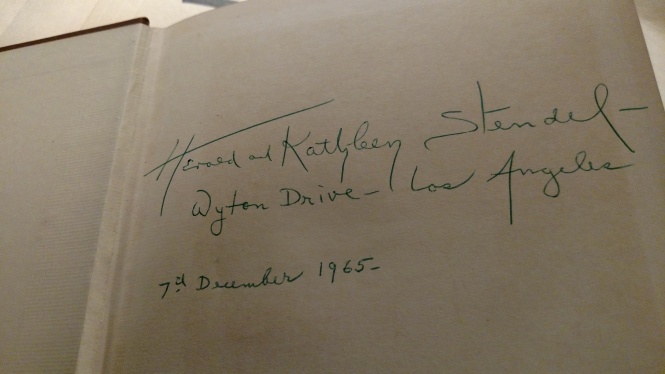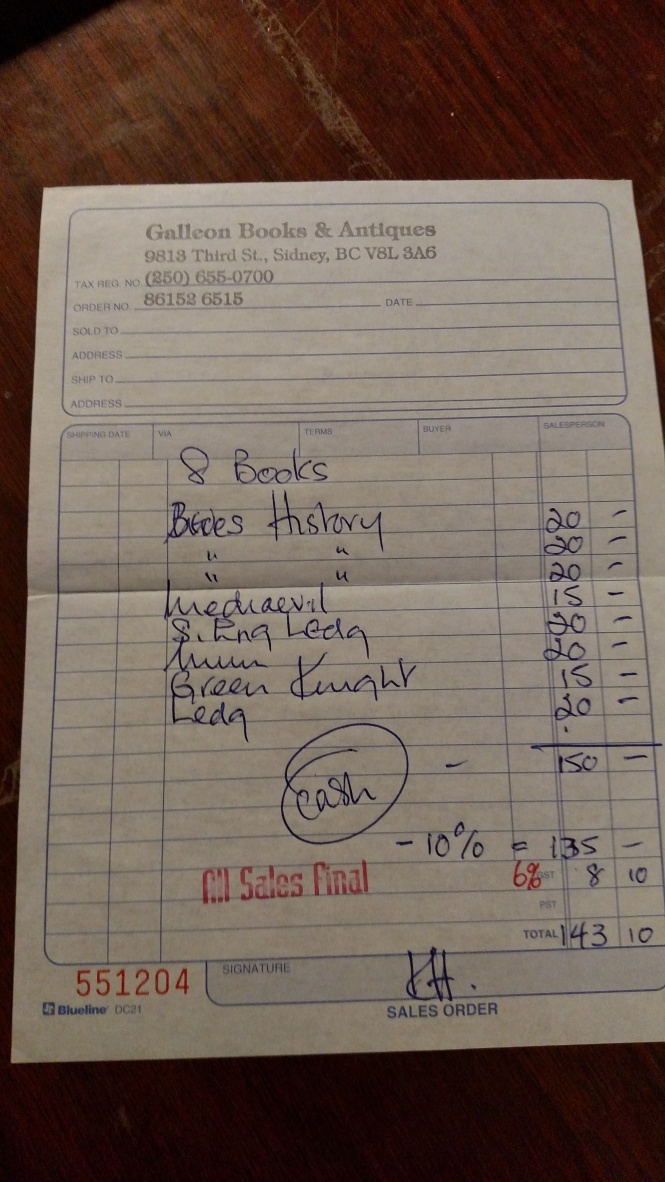The book I’m currently reading:

It’s fascinating. See my tweets for each day’s favorite find!
The book I’m currently reading:

It’s fascinating. See my tweets for each day’s favorite find!
So I bought a copy of the Early English Text Society edition of The South English Legendary:
 (Ever notice how you feel smarter already when you buy a book that comes in multiple volumes, the last of which is exclusively notes and commentary?)
(Ever notice how you feel smarter already when you buy a book that comes in multiple volumes, the last of which is exclusively notes and commentary?)
What is even cooler than the book(s) is that the set arrived with its own history tucked inside. The inscription of the original owners:

Okay, fine, I hear you, lot of books have their first (and sometimes subsequent) owners’ names written inside. Tough crowd.
But then there was this:

A letter from the EETS editor, to the original purchaser, and mentioning the Kennedy assassination. Complete with coffee mug stains from either sender or receiver.
And then:
 The bill of sale from when the set was bought used, having somehow made its way to British Columbia from Los Angeles.
The bill of sale from when the set was bought used, having somehow made its way to British Columbia from Los Angeles.
Not to mention the bill of sale I was actually expecting: 
(Close-eyed observers will note that this set had misplaced volume 3, no doubt on the hard trek to British Columbia. I ordered it separately.)
Either the owner(s) have an unusual commitment to history, keeping the sales receipts with the book(s), or this is a book that tends to be purchased more than read.
Weelll, it is a collection of edifying saints’ lives. Make up your own minds. Could go either way.
My day job is as medieval lit and contemporary fantasy part-time faculty at the University of Maryland.
This fall, I taught a seminar on the Harry Potter series and its adaptations. It was a great semester!
An exciting thing happened at the end of the semester: myself and one of my students were interviewed by Mugglenet Academia about the course.
The interview can be listened to or downloaded here.
So I’m reading this book at the moment:

I will probably will be reading it for months. It’s vast. But I’ve learned some seriously interesting stuff so far.
From the very first page: the high, pointy roof construction of most early medieval Irish churches means that the height difference between the churches and round towers beside them would be much less noticeable originally than it seems now, when in many cases the round tower is intact but the church is gone.
From chapter 1: Written and art sources suggest that many early Irish churches were wooden, but of course wood churches are considerably less permanent than stone ones. O Carragain mentions a recent excavation, though, at Balriggan, County Louth, which probably is the remains of one. This is of course nifty both for itself and for being in my favorite county in Ireland. For both the wooden churches and high-gabled stone ones, the pitch of the roof is so steep that the church ends up being as high as they were long.
There’s more in chapter one, but the next bit is so awesome I think I’ll save it for its own post.
Although we often talk about Saint Patrick evangelizing Ireland, it’s almost certainly the case that missionaries had already made significant inroads before he arrived.
There were enough Christians in Ireland to get the attention of Pope Celestine, who in 431 sent Palladius to shepherd them as bishop. We know this from an entry in Prosper of Aquitaine’s Chronicle (composed c 433–see Daibhi O Croinin’s Early Medieval Ireland: 400-1200, page 14).
Although Palladius is the first recorded evidence of Christians in Ireland, the new faith must have arrived earlier. After all, Palladius was sent to be bishop to an existing group of Christians large enough to need a bishop.
The Fadden More Psalter was unearthed in July 2006 from the Fadden More Bog, discovered by Eddie Fogarty as he was harvesting peat with an excavator. (We should pause here for a moment of thanks to Mr. Fogarty, for noticing the book in his excavator’s bucket and recognizing it was an important object. How many of us would recognize this muddy mess as a book?)
The book itself, alas, was in pretty bad shape (one is reminded of Yoda’s “When 900 years old you reach, look as good, you will not.”) Two elements of the book were especially exciting.
S&H Publishing put together this slick book trailer for THE LAST ABBOT OF LINN DUACHAILL.
How cool is that?
So I was guest blogging this week at Killer Crafts & Crafty Killers about the Book of Kells and what’s involved in creating illuminated manuscripts.
http://www.anastasiapollack.blogspot.com/2015/07/crafts-with-anastasia-guest-author.html
So I received the newest Locus. THIS was in the section about Forthcoming Releases:
And then I had a nightmare that I’d imagined the whole thing, there was no mention in Locus or any publication happening AT ALL. But it was still there the next day.
Right, like I’m the only nervy debut author out there. Yup. Just me. The rest of y’all are like cucumbers.
Not without some serious trepidation, we started watching my favorite favorite all-time favorite (no really, I was obsessed–I collected newspaper clippings, magazine articles, episode announcements in the TV guide, etc) middle-school era show: Scarecrow and Mrs. King.
Mercifully (unlike, say, The A-Team), the re-watch did not make me want to time-travel to slap the stupid out of my younger self. My younger self is, admittedly, as much of a sentimental sap as my older self, but I can live with that.
During season three, I suddenly realized how much Leroy Jethro Gibbs looks like an older Lee Stetson. I’d already linked Bones and NCIS in my head. Ralph Waite played both Gibbs’ father and Booth’s grandfather, so naturally Booth and Gibbs are related.
Which is how I ended up writing my first piece of fanfic.
Yup, a whole collection of guilty pleasures to fess up to.
You must be logged in to post a comment.